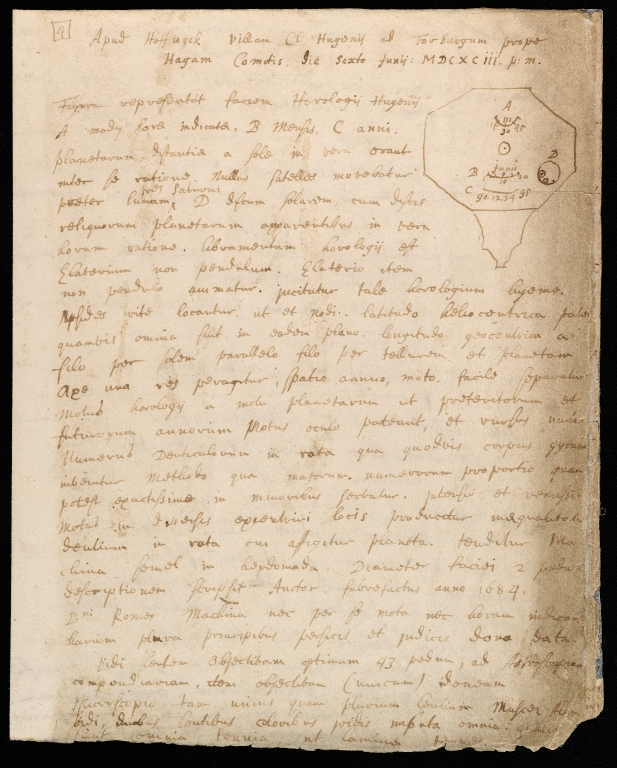Newton, Sir Isaac, 1642-1727 (mathematician and astronomer)
Person
Found in 7 Collections and/or Records:
Astronomiae Physicae et Geometricae Elementa, 28 February 1698
Item
Identifier: Coll-33/Quarto A [43]
Scope and Contents
Notes from a London meeting with Sir Isaac Newton on a revised plan for the Astronomiae physicae et geometricae elementa, (1702), Gregory's most important work. An erratum lies at the foot of this document, unrelated to it or to any of the other things on the sheet (which have their own entries in Gregory's index): a jotting about refraction, crystals, and cataracts of the eye. This is dated London, 30 May 1708.
Dates:
28 February 1698
Diagram by Newton, c1692
Item
Identifier: Coll-33/Folio E [037]
Scope and Contents
A diagram of how light propagates serially through convex lenses.
Dates:
c1692
Excerpta et notanda in Kepleri ... ad vitellionem, c1693
Item
Identifier: Coll-33/Quarto A [38.1]
Scope and Contents
A discussion, probably inspired by Sir Isaac Newton, of whether it was Willebrord Snell or Voss who discovered a law of refraction first, from which Rene Descartes arguably derived his version at last.
Dates:
c1693
Jo: Keil Scheda de figura Radij in Medio difformi, 1684-1700
Item
Identifier: Coll-33/Quarto A [30]
Scope and Contents
A logarithmic treatment of light propagating through a uniform medium. John Keill was an Edinburgh native who earned distinction under David Gregory in mathematics and natural philosophy there, and who followed him to Oxford in 1691, where, like Gregory, he made a name for himself as an enthusiastic vindicator of Sir Isaac Newton. At Balliol College he demonstrated by experiments the validity of some of the chief propositions of Newton concerning light and colour, among other things. Oddly,...
Dates:
1684-1700
Mr Whistons mistakes in his new theory, 3 April 1698
Item
Identifier: Coll-33/Quarto A [45]
Scope and Contents
A short critique of William Whiston's A New Theory of the Earth, from its Original to the Consummation of all Things, (1696) , intended to damn Cartesian astronomy and advance corollaries to Newtonian thought instead. He affirmed the truth of the flood narrative in Genesis, ascribing the deluge to the impact of a comet. Whiston had been converted to Newtonianism by a paper of David Gregory. At the foot of this document is an unrelated note, dated 6 Sept. 1708, to...
Dates:
3 April 1698
Notanda D.J. phys. et math. Lond: Martio 1693 cum Fatio, 31 March 1693
Item
Identifier: Coll-33/Quarto A [37]
Scope and Contents
Notes to an extended conversation with Fatio de Duillier, fellow enthusiast of Newtonian science at Oxford, and especially important to Gregory between December 1691 and May 1694, when he was cut off from direct contact with Sir Isaac Newton, whom he had offended in a published commentary on his 'abrumpent' mathematical series. Topics include magnetic attraction, refraction and colour, and movement of solids through fluid, with anecdotal remarks by de Duiller about ships, tides, and the...
Dates:
31 March 1693

Papers of David Gregory
Fonds
Identifier: Coll-33
Scope and Contents
The papers of David Gregory consist of:
bound manuscripts of mathematical and personal papers by both David Gregory and James Gregory
bound manuscripts Lectiones Mechanicae Sive Geometria de Motu parts 1-4 (1689-1690)
bound manuscripts of treatises on mathematics and astronomy (1683-1694)
bound manuscripts ...
Dates:
1652-1706
Filtered By
- Subject: Optics X
Additional filters:
- Type
- Archival Object 6
- Collection 1
- Subject
- Mathematics 4
- Astronomy 3
- Physics 2
- Achromatic Telescope 1
- Astrophysics 1
- Catenary 1
- Celestial Mechanics 1
- Comets 1
- Crystals 1
- Dynamics 1
- Flood, Biblical 1
- Geodesy 1
- Geodetic Astronomy 1
- Geometry 1
- Geometry, Elemental 1
- Gravity 1
- Horology 1
- Lunar Theory 1
- Magnetism 1
- Numerical Integration 1
- Oxford Oxfordshire England 1
- Philosophy 1
- Professional Criticism 1
- Professional Links 1
- Quadratures 1
- Refraction 1
- Ships 1
- Vision Disorders 1 + ∧ less
∨ more

